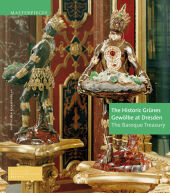 Neuerscheinungen 2014Stand: 2020-02-01 |
Schnellsuche
ISBN/Stichwort/Autor
|
Herderstraße 10
10625 Berlin
Tel.: 030 315 714 16
Fax 030 315 714 14
info@buchspektrum.de |

Jutta Kappel, Dirk Syndram, Ulrike Weinhold
(Beteiligte)
The Historic Grünes Gewölbe at Dresden
The Baroque Treasury
3. Aufl. 2014. 180 S. 17 b/w and 129 col. ill. 280 mm
Verlag/Jahr: DEUTSCHER KUNSTVERLAG 2014
ISBN: 3-422-07286-1 (3422072861)
Neue ISBN: 978-3-422-07286-2 (9783422072862)
Preis und Lieferzeit: Bitte klicken
The famous "Historisches Grünes Gewölbe" returns to the residential palace for the first time after 60 years in September 2006. The beautifully illustrated catalogue takes the reader on a fascinating tour through this unique "Gesamtkunstwerk". The "Grünes Gewölbe" was founded in 1550 by Elector August of Saxony as the state treasury, "Geheime Verwahrung." Augustus the Strong converted it into a publicly accessible Schatzkunst museum in 1729. His idea was unrivalled: the eight display rooms with their exquisite interiors and the highly impressive mise en scène of the collection were designed to inspire amazement. The extravagant profusion of precious objects in gold, silver, enamel and precious stones, the ivories, bronzes and jewellery proclaimed the wealth and artistic taste of the Saxon dynasty. In 1942 the collection was closed and taken into storage at Königstein fortress. The museum´s exterior and three of the eight rooms were severely damaged during the war. From 1974 a part of the collection could be seen again, but it was not until 2004 when the "Neues Grünes Gewölbe" was reopened with exhibits from the Renaissance to Neo-Classicism. The book introduces the masterpieces of this fascinating collection and provides an insight into the brilliant concept of the museum´s founder, from which the inspiration for this presentation has been drawn.
The famous "Historisches Grünes Gewölbe" returns to the residential palace for the first time after 60 years in September 2006. The beautifully illustrated catalogue takes the reader on a fascinating tour through this unique "Gesamtkunstwerk".
The "Grünes Gewölbe" was founded in 1550 by Elector August of Saxony as the state treasury, "Geheime Verwahrung." Augustus the Strong converted it into a publicly accessible Schatzkunst museum in 1729. His idea was unrivalled: the eight display rooms with their exquisite interiors and the highly impressive mise en scène of the collection were designed to inspire amazement. The extravagant profusion of precious objects in gold, silver, enamel and precious stones, the ivories, bronzes and jewellery proclaimed the wealth and artistic taste of the Saxon dynasty.
In 1942 the collection was closed and taken into storage at Königstein fortress. The museum´s exterior and three of the eight rooms were severely damaged during the war. From 1974 a part of the collection could be seen again, but it was not until 2004 when the "Neues Grünes Gewölbe" was reopened with exhibits from the Renaissance to Neo-Classicism. The book introduces the masterpieces of this fascinating collection and provides an insight into the brilliant concept of the museum´s founder, from which the inspiration for this presentation has been drawn.
Prof. Dr. Dirk Syndram ist seit 1993 Direktor des Grünen Gewölbes. Der Kunsthistoriker ist zudem seit 2002 verantwortlich für die gesamte Neueinrichtung des Dresdner Residenzschlosses. Er studierte Kunstgeschichte, Ägyptologie und Archäologie an der Universität Hamburg. Nach mehrmonatigen Forschungsaufenthalten in London und Paris promovierte er 1985 mit der Arbeit"Ägypten-Faszinationen. Untersuchungen zum Ägyptenbild im europäischen Klassizismus bis 1800". Von 1986 bis 1987 war er als wissenschaftlicher Museumsassistent bei den Staatlichen Museen Preußischer Kulturbesitz in Berlin tätig. Von 1987 bis 1992 leitete er die im Aufbau befindliche Kunstgewerbesammlung/Stiftung Huelsmann in Bielefeld. Syndram betont, im Grünen Gewölbe handele es sich um"die einzig erhaltene Schatzkammer des Barocks"dieser Größe.


